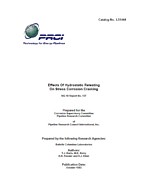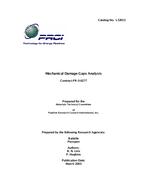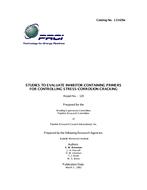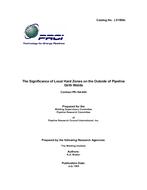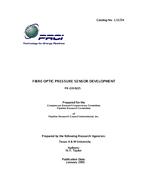Provide PDF Format
PRCI Report 137
- Effects of Hydrostatic Retesting on Stress Corrosion Cracking
- Report / Survey by Pipeline Research Council International, 10/01/1983
- Publisher: PRCI
$148.00$295.00
L51444e
Battelle Memorial Institute
Need: The problem of stress-corrosion cracking in gas transmission pipelines has been the subject of research sponsored by Pipeline Research Council International, Inc. and supervised by the NG-18 Line Pipe Research Committee. This research effort is directed towards practical solutions that can be applied to new and existing pipelines. However, it is recognized that stress-corrosion cracking is a time dependent process and, in general, it is not yet possible to locate where, or identify when, stress corrosion cracking is occurring. In lieu of this information, the industry has developed procedures to locate and eliminate stress-corrosion cracks or other defects in the pipe, should they occur. Hydrostatic retesting is a destructive pressure test of breaking out those stress-corrosion cracks that could result in a leak or rupture in service and straining other cracks or flaws that survive the retest.
Result: Stress-corrosion cracking experiments were carried out in the laboratory to determine the effect of hydrostatic retest pressure on the subsequent growth of cracks that survive the retest. For these experiments, 8-inch diameter pressurized pipe specimens were used with various size notches machined into the pipe to simulate preexisting stress-corrosion cracks. Experiments were conducted with the notches covered by a 4.8 percent sodium carbonate + 7.6 percent sodium bicarbonate environment at 175 F and held at -720 mV (Cu/CuS04) as the pipes were subjected to various cyclic operating pressures from about 50 percent to 85 percent SMYS and to hydrostatic retest pressures of either 90, 100, or 110 percent SMYS held for 24 hours. The effect of hydrostatic retest pressure was assessed from post-test crack-growth rate measurements on the notches in companion experiments, one pipe held at the operating pressure for about 1 month and the other held similarly but with the intervening hydrostatic retest.
Benefit: Pipeline operators can determine the optimum conditions for flaw removal (hence increasing time between tests) while avoiding conditions that will reactivate passive cracks or accelerate cracking in active cracks.
Battelle Memorial Institute
Need: The problem of stress-corrosion cracking in gas transmission pipelines has been the subject of research sponsored by Pipeline Research Council International, Inc. and supervised by the NG-18 Line Pipe Research Committee. This research effort is directed towards practical solutions that can be applied to new and existing pipelines. However, it is recognized that stress-corrosion cracking is a time dependent process and, in general, it is not yet possible to locate where, or identify when, stress corrosion cracking is occurring. In lieu of this information, the industry has developed procedures to locate and eliminate stress-corrosion cracks or other defects in the pipe, should they occur. Hydrostatic retesting is a destructive pressure test of breaking out those stress-corrosion cracks that could result in a leak or rupture in service and straining other cracks or flaws that survive the retest.
Result: Stress-corrosion cracking experiments were carried out in the laboratory to determine the effect of hydrostatic retest pressure on the subsequent growth of cracks that survive the retest. For these experiments, 8-inch diameter pressurized pipe specimens were used with various size notches machined into the pipe to simulate preexisting stress-corrosion cracks. Experiments were conducted with the notches covered by a 4.8 percent sodium carbonate + 7.6 percent sodium bicarbonate environment at 175 F and held at -720 mV (Cu/CuS04) as the pipes were subjected to various cyclic operating pressures from about 50 percent to 85 percent SMYS and to hydrostatic retest pressures of either 90, 100, or 110 percent SMYS held for 24 hours. The effect of hydrostatic retest pressure was assessed from post-test crack-growth rate measurements on the notches in companion experiments, one pipe held at the operating pressure for about 1 month and the other held similarly but with the intervening hydrostatic retest.
Benefit: Pipeline operators can determine the optimum conditions for flaw removal (hence increasing time between tests) while avoiding conditions that will reactivate passive cracks or accelerate cracking in active cracks.
Related Products
PRCI PR-003-0277
Review & Gap Analysis of Remaining Issues Concerning Mechanical Damage..
$48.00 $95.00
PRCI Report 129
Studies to Evaluate Inhibitor-Containing Primers for Controlling Stress-Corrosion Cracking..
$148.00 $295.00

